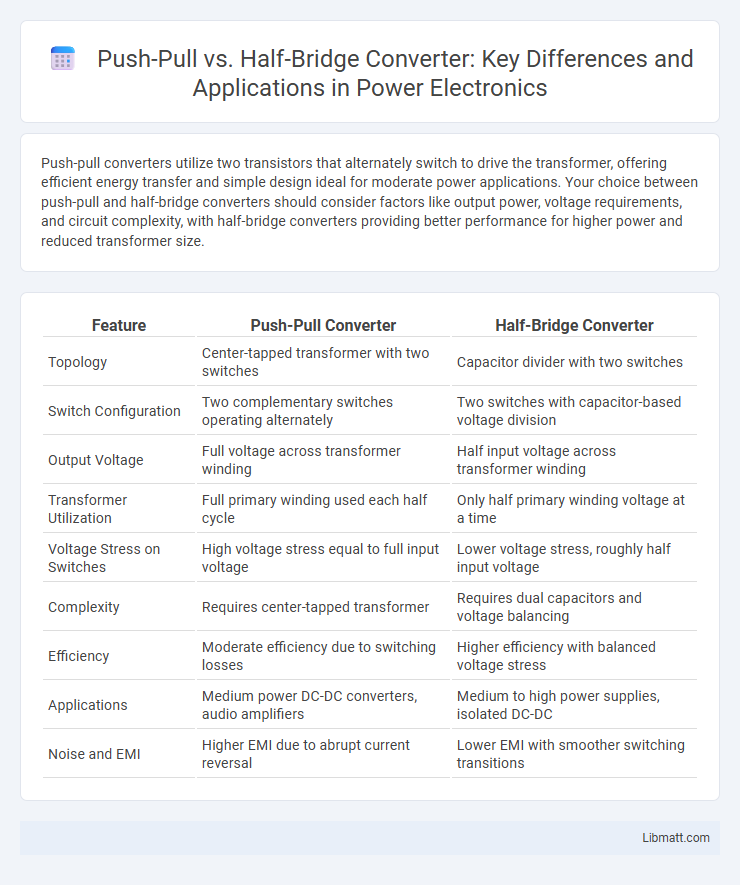Push-pull converters utilize two transistors that alternately switch to drive the transformer, offering efficient energy transfer and simple design ideal for moderate power applications. Your choice between push-pull and half-bridge converters should consider factors like output power, voltage requirements, and circuit complexity, with half-bridge converters providing better performance for higher power and reduced transformer size.
Table of Comparison
| Feature | Push-Pull Converter | Half-Bridge Converter |
|---|---|---|
| Topology | Center-tapped transformer with two switches | Capacitor divider with two switches |
| Switch Configuration | Two complementary switches operating alternately | Two switches with capacitor-based voltage division |
| Output Voltage | Full voltage across transformer winding | Half input voltage across transformer winding |
| Transformer Utilization | Full primary winding used each half cycle | Only half primary winding voltage at a time |
| Voltage Stress on Switches | High voltage stress equal to full input voltage | Lower voltage stress, roughly half input voltage |
| Complexity | Requires center-tapped transformer | Requires dual capacitors and voltage balancing |
| Efficiency | Moderate efficiency due to switching losses | Higher efficiency with balanced voltage stress |
| Applications | Medium power DC-DC converters, audio amplifiers | Medium to high power supplies, isolated DC-DC |
| Noise and EMI | Higher EMI due to abrupt current reversal | Lower EMI with smoother switching transitions |
Introduction to Push-Pull and Half-Bridge Converters
Push-Pull converters utilize two transistors that alternately switch to drive the transformer primary winding, providing efficient power conversion with symmetrical magnetizing flux, suitable for medium power applications. Half-Bridge converters employ two switches and two capacitors dividing the input voltage, creating a midpoint reference that drives the transformer, enhancing voltage stress management and improving power efficiency. Both topologies are widely used in isolated DC-DC conversion with distinct advantages in power handling, voltage stress, and transformer utilization.
Basic Working Principles of Push-Pull Converters
Push-pull converters utilize a center-tapped transformer and two transistors that alternately switch on and off, driving current through the transformer windings in opposite directions to transfer energy efficiently. This configuration enables voltage step-up or step-down with high efficiency and reduced transformer core saturation due to balanced magnetic flux in the core. The basic operation involves periodic switching to produce an AC waveform from a DC input, which is then rectified and filtered to provide a stable DC output voltage.
Basic Working Principles of Half-Bridge Converters
Half-bridge converters operate by using two switches connected in series across a DC supply, creating alternating voltage pulses at the midpoint to drive the load through a transformer. This topology splits the input voltage, reducing stress on components and enabling efficient energy transfer with minimal distortion. The half-bridge converter's design enables balanced operation and improved power handling in medium-power applications.
Topology Comparison: Circuit Design Differences
Push-pull converters utilize a center-tapped transformer with two transistors alternately switching to drive the transformer windings, enabling efficient energy transfer and simpler control for moderate power levels. Half-bridge converters employ a pair of transistors connected in series with a midpoint tap tied to the transformer, allowing for higher voltage utilization and reduced transformer size by using a split supply configuration. The push-pull topology offers symmetrical drive and inherent transformer reset, while the half-bridge design benefits from reduced voltage stress on components and improved efficiency at higher power ratings.
Efficiency Analysis: Push-Pull vs Half-Bridge
Push-Pull converters generally offer simpler design and lower component count but may suffer from core saturation and higher conduction losses, impacting overall efficiency. Half-Bridge converters feature improved efficiency through better voltage utilization, reduced stress on power devices, and balanced transformer excitation, making them suitable for medium to high power applications. Your choice depends on the specific power requirements and desired efficiency targets, with half-bridge typically providing superior efficiency in demanding scenarios.
Transformer Utilization and Core Saturation
The push-pull converter offers better transformer utilization by allowing both halves of the core to conduct alternately, maximizing the magnetic flux swing and improving efficiency. In contrast, the half-bridge converter uses only one half of the transformer core at a time, leading to lower transformer utilization and increased risk of core saturation under higher loads. Your choice between these topologies directly impacts the transformer size, core loss, and overall converter performance.
Voltage Stress and Component Ratings
Push-pull converters exhibit higher voltage stress on the switches due to the center-tapped transformer configuration, requiring components with voltage ratings typically double the input voltage. Half-bridge converters reduce voltage stress by splitting the input voltage across two switches, resulting in lower voltage requirements for each component and improved efficiency. This difference in voltage stress directly impacts the selection of semiconductor devices and affects the overall reliability and cost of the converter design.
Cost Considerations and Component Count
Push-pull converters typically have a higher component count due to the use of two transistors and a center-tapped transformer, which can increase overall manufacturing costs. Half-bridge converters reduce component count by using only two switches without the need for a center-tapped transformer, leading to lower costs and simplified PCB layouts. Cost considerations often favor half-bridge designs in high-volume production where component reduction directly impacts price efficiency.
Applications and Suitability in Power Electronics
Push-pull converters excel in low to medium power applications, such as battery chargers and small power supplies, due to their simplicity and cost-effectiveness. Half-bridge converters are more suitable for medium to high power applications, including industrial motor drives and renewable energy systems, offering higher efficiency and better voltage stress distribution. Your choice depends on required power levels, efficiency needs, and specific load characteristics in power electronics designs.
Choosing the Right Converter: Key Decision Factors
Choosing between a Push-Pull and Half-Bridge converter depends on factors like power level, efficiency, and complexity. Push-Pull converters are ideal for moderate power applications with simple design requirements, while Half-Bridge converters offer better efficiency and voltage handling for higher power levels. Your choice should consider load demands, cost constraints, and thermal management needs to optimize performance and reliability.
Push-Pull vs Half-Bridge Converter Infographic

 libmatt.com
libmatt.com